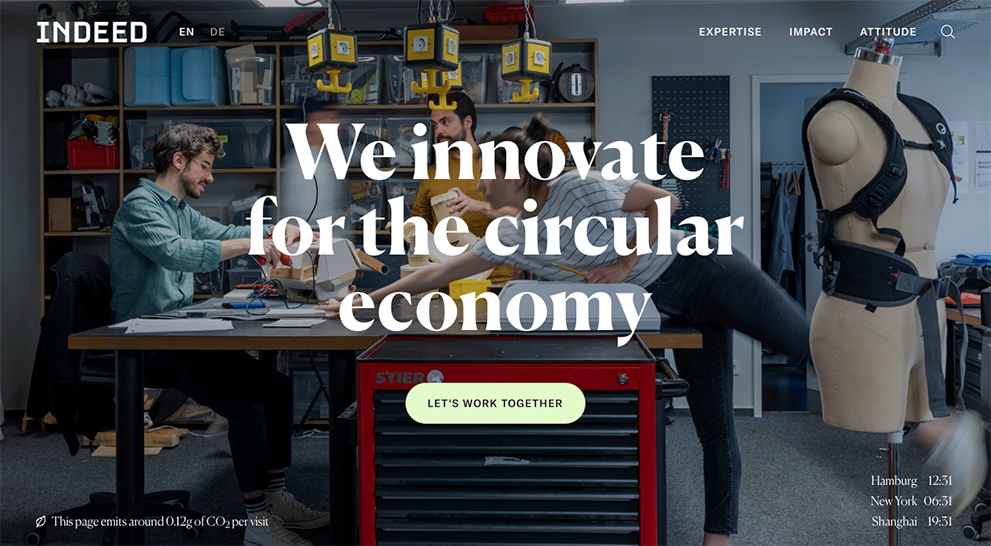In Conversation With: Tom Greenwood

With the growing attention surrounding digital technology’s high carbon emissions, your team may well be considering how to reduce the emissions from your company’s web presence. We spoke to sustainable business and design expert Tom Greenwood about the latest trends, which companies are getting it right, and some initial steps you can take to make your corporate website greener

Indeed Innovation’s home page features the amount of CO2 emitted per visit in the bottom left corner
Caterina Sorenti (CS): What are the new and emerging digital carbon emissions trends to look out for in the next 12 months?
Tom Greenwood (TG): I think the emerging trend will be low energy, darker colour palettes or dark modes. Another emerging trend may be the increase in organisations reporting real time energy and emissions data on their websites and even adapting the website content and design to reduce emissions when the national grid has less renewable energy available.
CS: Who is doing this well right now, and why?
TG: Companies such as Aliter Networks and Indeed Innovation have updated their brand identity to support use of lower energy, dark colours online. I think this is a really good example of integrating sustainability thinking not just into the web design, but more holistically into the brand design that will underpin all online activities.
As for designs that adapt to the carbon intensity of the energy grid, this is very much cutting edge at the moment but a good example is Branch magazine which has a "Grid Intensity View" in the header.
CS: What are some initial steps to take for corporate digital managers starting out with carbon efficiency?
TG: Awareness of the carbon impact of digital technology is very low so as an initial step I recommend getting familiar with the topic and potential solutions. A tool like WebsiteCarbon.com is a good place to start, as is my book, Sustainable Web Design. With some basic awareness in hand, I think the best place to start is to pick one thing that could be improved and focus on trying to do that well, rather than trying to do everything at once. Often the easiest and most impactful thing to start with is to look at imagery on the website, to see where it can be reduced and whether the images can be optimised to load as smaller files. Doing so will also help improve website load times and help engage designers, developers and marketers in the process.
CS: For many of our clients, considering carbon efficiency on the corporate website is new. Can you explain the concept of the 'carbon budget' - what it is and how it can help frame the issue and help communicate it to colleagues?
TG: A carbon budget is a way of setting a target for emissions reduction on a website. Using a tool like Website Carbon or EcoGrader, the project team can benchmark existing pages and competitor pages before they begin. From this, they can then set themselves a target for improvement. This target would be a maximum amount of CO2e that they would permit for their own web pages, or a budget to work within. For example, if the current website has emissions of 2 grams CO2e per page but they can see that other websites in their sector have emissions ranging from 1-1.5 grams CO2e per page view, then they may decide that they want to set themselves a budget of 1 gram, or even lower in order to demonstrate best practice. This can help focus the minds of designers and developers in analysing the impact of their decisions.
An alternative to a carbon budget is a page weight budget, whereby the team sets a maximum budget of the amount of data loaded for each page. Although it is not a pure environmental metric, it can be used to the same effect as a carbon budget but can be easier for designers and developers to work with because they can easily add up the size of design elements and code in terms of kilobytes.